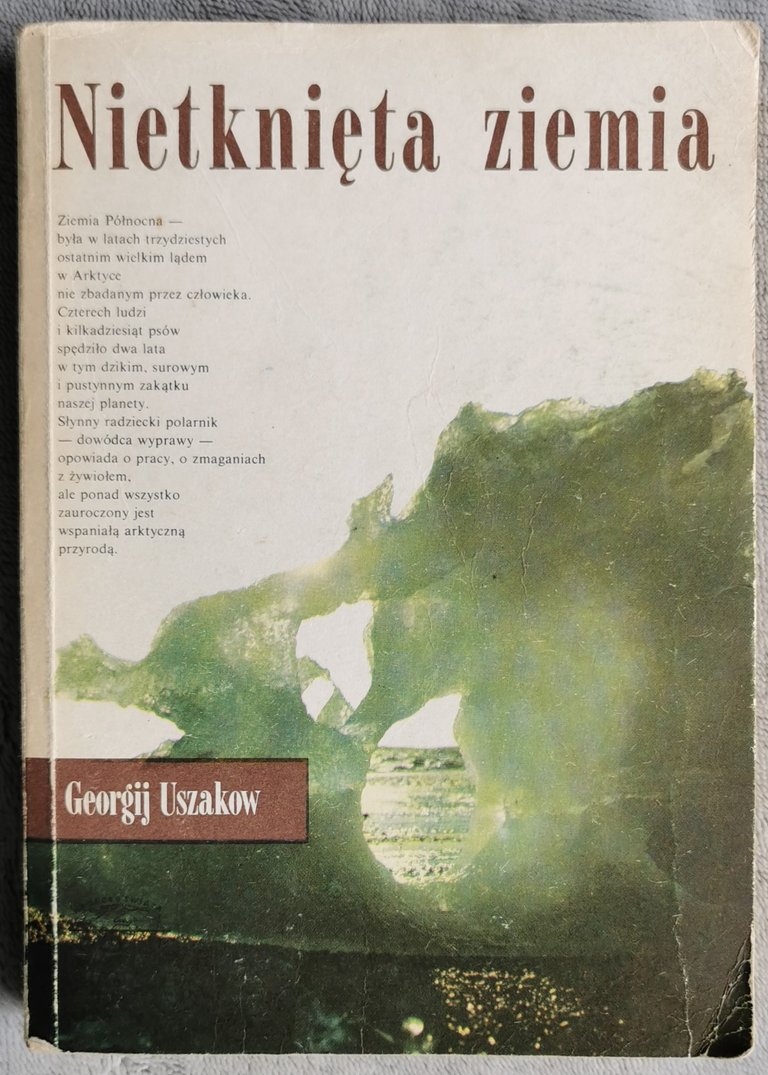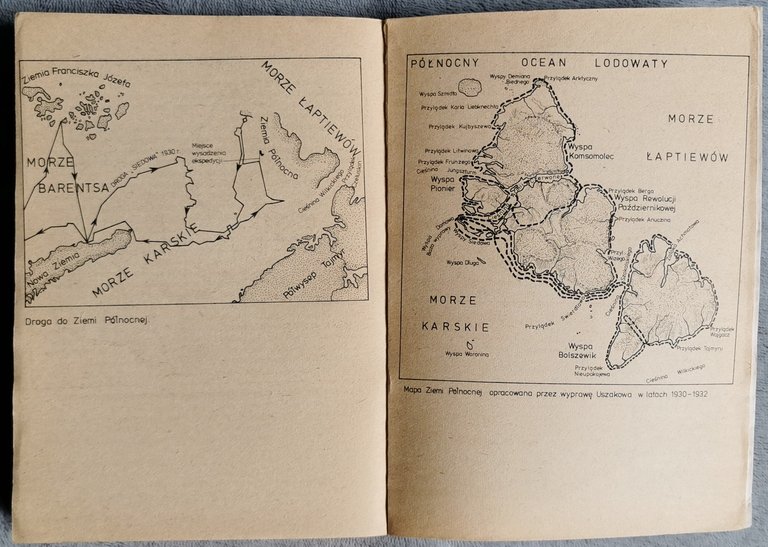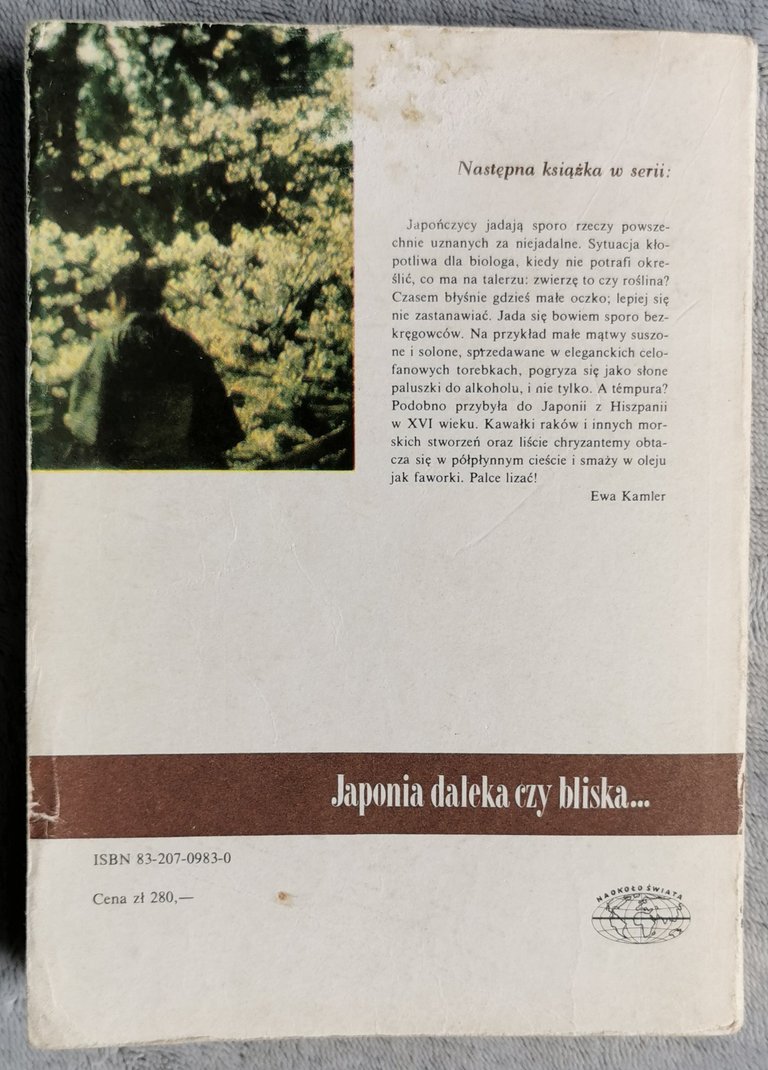| Dzisiejszym odcinkiem zabieram Was w podróż na Ziemię Północną – fragment Arktyki najdłużej opierający się próbom eksploracji przez człowieka. Jeszcze sto lat temu wiedzieliśmy, co prawda, o jego istnieniu i z grubsza wiedzieliśmy, gdzie się znajduje, ale bardziej konkretne informacje pozostawały poza naszym zasięgiem. Do czasu, gdy w 1930 na nieznane tereny wyruszyła ekspedycja radzieckich polarników w składzie: Gieorgij Uszakow, Nikołaj Urwancew, Siergiej Żurawlow, Wasilij Chodow i kilkadziesiąt psów. O ich zmaganiach z nieznanym w warunkach podbiegunowych opowiada właśnie ta książka, której autorem jest sam dowódca wyprawy. | In today's episode, I take you on a journey to Severnaya Zemlya - the part of the Arctic that has longest resisted attempts at human exploration. Until a hundred years ago, we knew of its existence and had a rough idea of its location, but more detailed information remained out of reach. Until 1930, when an expedition of Soviet polar explorers, consisting of Georgy Ushakov, Nikolai Urvantsev, Sergei Zhuravlev, Vasily Khodov and several dozen dogs, set off into unknown territory. This book, written by the expedition leader himself, tells the story of their struggle with the unknown in polar conditions. |
| Uszakow opisuje trudy tego, niewątpliwie, wielkiego przedsięwzięcia, które nawet dziś, w czasach, gdy dysponujemy najnowocześniejszą technologią, byłoby rzeczą niebagatelną. A cóż dopiero wtedy – kiedy szczytem dostępnej techniki było radio, a i ono czasami zawodziło? Przed czytelnikami jawi się możliwość dołączenia do takiej wyprawy – choćby i po latach, choćby tylko w wyobraźni i przekonania się, choćby tylko w niewielkim stopniu, jak wielkie było to wyzwanie. | Ushakov describes the difficulties of what was undoubtedly a huge undertaking, which even today, with the most modern technology, would be a considerable thing. But what about then - when radio was the pinnacle of available technology, and even that sometimes failed? Readers are given the opportunity to join such an expedition - even years later, if only in their imagination - and see, if only in a small way, how great the challenge was. |
| Żeby nie być gołosłownym, spróbujcie sobie wyobrazić – czwórka ludzi (w zasadzie trójka, bo najmłodszy z nich, osiemnastoletni zaledwie Wasia Chodow, pozostawał w bazie jako radiotelegrafista), około 7000 kilometrów przemierzonych po bezkresnych lodowcach na zaprzężonych w psy, pełnych ładunku saniach, również w czasie pozbawionej światła wielomiesięcznej nocy polarnej, tylko i aż po to, by zbadać to, co dotychczas niezbadane. By sporządzić mapy nieznanego lądu, wyznaczyć jego brzegi i poznać jego charakter badacze narażali się, chociażby, na śnieżną ślepotę i spotkania z niedźwiedziami polarnymi, nie mówiąc o tak „zwykłych” zagrożeniach, jak lodowe szczeliny czy huraganowe zamiecie. | Imagine - four people (actually three, as the youngest, 18-year-old Vasya Khodov, stayed at the base as a radio operator), some 7,000 kilometres on a dog-drawn sledge, full of cargo, across endless glaciers, without seeing the Sun for months, as the polar night that lasts so long, just to explore what had not yet been explored. In order to map the unknown land, determine its boundaries and learn about its nature, the explorers risked such things as snow blindness and encounters with polar bears, not to mention such 'ordinary' dangers as ice crevasses and hurricane blizzards. |
| Oczywiście, wyobrażenie sobie tego będzie łatwiejsze dzięki relacji kierownika wyprawy. Przedstawia nam jej przebieg od momentu oficjalnego zatwierdzenia, poprzez przygotowania organizacyjne (ze szczególnym naciskiem na kwestie finansowania projektu i pozyskania najlepszych psów pociągowych), następnie długie miesiące, podczas których mogli liczyć tylko na siebie, bez najmniejszych szans na pomoc z zewnątrz, aż do szczęśliwego powrotu. Pozwala nam uczestniczyć nie tylko w trudach wyprawy, ale też w jej radościach i – czasami – smutkach (szczególnie poruszające są momenty, gdy radiotelegrafista odbiera wiadomości od rodziny myśliwego Żurawlowa). Każdy z czytelników ma szanse sobie wyobrazić, czy byłby w stanie podołać takim trudom choćby przez parę dni. I docenić siłę – fizyczną, ale też, a może nawet bardziej – psychiczną – radzieckich polarników. | Of course, this is easier to imagine thanks to the narration of the expedition leader. He shows us the course of the expedition from the moment it was officially approved, through the organisational preparations (with particular emphasis on the issues of financing the project and acquiring the best draft dogs), then the long months during which they had to count on themselves without the slightest chance of outside help, up to the happy return. It allows us to share not only the hardships of the expedition, but also its joys and - sometimes - its sorrows (the moments when the radio operator receives messages from the wife of the hunter Zhuravlev are particularly moving). Each reader has the chance to imagine whether he or she would be able to endure such hardship, even for a few days. And to appreciate the strength - both physical and, perhaps even more so, mental - of the Soviet polar explorers. |
| Co się tyczy samego opisu… Przede wszystkim jest on niesymetryczny. Autor poświęca bardzo dużo miejsca i uwagi pierwszemu rokowi, zwłaszcza pierwszej nocy polarnej, badania drugoroczne traktując już bardziej po macoszemu, zapewne ze względu na duże podobieństwo sytuacji. Druga kwestia – Uszakow bardzo dobrze sobie radzi z opisem codzienności w Arktyce, wyobraźnia nie ma wielkich problemów z przedstawieniem sobie, na przykład, wyglądu stacji, strojów polarnych, wyposażenia sań, arktycznej fauny i flory czy nawet sztuki kulinarnej polarników. Pod tym względem trudno mieć zastrzeżenia co do jego warsztatu pisarskiego. Niestety sytuacja zmienia się diametralnie, gdy przechodzi do opisów wielkoskalowych. Próby przedstawienia krajobrazów i konkretnych miejsc są moim zdaniem niezbyt udane. Nie jest łatwo na ich podstawie wyobrazić sobie, na przykład, ukształtowanie terenu, czy wzajemne relacje przestrzenne między poszczególnymi fragmentami tras. Sytuację można by, zapewne, w jakimś stopniu uratować dzięki mapkom, pokazującym przebieg eksploracji. Niestety do dyspozycji dostajemy tylko dwie, pokazujące cały nowozbadany ląd (więc siłą rzeczy mniej szczegółowe niż opisy) – a i to już po przeczytaniu książki, na jej dwóch ostatnich stronach. | As for the description itself... First of all, it is asymmetrical. The author devotes a lot of space and attention to the first year, especially to the first polar night, and treats the second year's research more negligently, probably because of the great similarity of the situation. The second point is that Ushakov does a very good job of describing everyday life in the Arctic, the imagination has little trouble imagining, for example, the appearance of the station, polar costumes, sledge equipment, Arctic flora and fauna, or even the culinary arts of the polar explorers. In this respect, it is difficult to find fault with his writing. Unfortunately, the situation changes dramatically when he turns to large-scale descriptions. The attempts to describe landscapes and specific places are, in my opinion, not very successful. It is not easy to imagine, for example, the lay of the land or the spatial relationships between different parts of the routes. The situation could, I suppose, be remedied to some extent by maps showing the course of the exploration. Unfortunately, there are only two of these, and they show the whole of the newly explored land (so inevitably less detailed than the descriptions) - and even that is after you have read the book, on the last two pages. |
| Byłoby naprawdę wskazane załączać je częściej i w większych detalach. Bo tak jak jest – naprawdę niełatwo sobie, czytając, wyobrazić przebieg zarówno tras badawczych, jak i kształt lądu, lokalizację wszystkich tych wysp, przylądków i cieśnin nazwanych, oczywiście, typowymi radzieckimi nazwami… | It would really be advisable to include them more often and in greater detail. For as it is - it is really not easy to imagine, while reading, the course of the survey routes, the shape of the land, the location of all those islands, capes and straits, named, of course, with typical Soviet names.... |
| Z tego powodu książkę czyta się nierówno. Są fragmenty, które przykuwają uwagę czytelnika i dają mu dużo przyjemności z lektury, ale są też i takie (do tego wcale niemało), które mocno utrudniają skupienie się i śledzenie narracji autora. Brakuje mi też – w polskim wydaniu z 1987 roku – jakiegoś posłowia, które przedstawiałoby dalsze losy bohaterów. Z którego dowiedzielibyśmy się, że dowódca, na przykład, został później członkiem Akademii Nauk ZSRR, że jego imieniem nazwano odkrytą przezeń wyspę, ostatni nieznany fragment rosyjskiej Arktyki. I że został pochowany na tej samej wyspie, na której przez dwa lata ekspedycji mieściła się jej główna baza. Że geolog Urwancew padł ofiarą czystek zaledwie kilka lat po powrocie z wyprawy i, zanim został zrehabilitowany i mógł powrócić do swoich badań, spędził kilka lat w łagrze. Że myśliwego Żurawlowa zmogły trudy jednej z kolejnych wypraw i zmarł ledwie pięć lat po powrocie z Ziemi Północnej. I że młody radiotelegrafista pozostał wierny temu zajęciu również w latach powojennych, jako naczelnik łączności w zarządzie Północnej Drogi Morskiej, czy też później jako naczelnik całego Diksońskiego Rejonu Arktycznego. I może chociaż paru zdjęć z wyprawy mi brakuje – choćby tylko jej uczestników. Na szczęście dziś internet pozwala do takich informacji dotrzeć. A całościową ocenę książki pozwolę sobie ustawić jako, mimo wszystko, „niezłą”, czyli 6 na 10. | As a result, the book reads unevenly. There are passages that capture the reader's attention and make it a pleasure to read, but there are also passages (quite a few) that make it very difficult to concentrate and follow the author's narrative. I also miss - in the Polish edition of 1987 - some kind of epilogue that would present the fate of the characters. It would have told us, for example, that the commander later became a member of the Soviet Academy of Sciences, that the island he discovered, the last unknown fragment of the Russian Arctic, was named after him. And that he was buried on the same island where the expedition had its main base for two years. That the geologist Urvantsev fell victim to purges just a few years after returning from the expedition and spent several years in a gulag before being rehabilitated and allowed to return to his research. That the hunter Zhuravlev was crushed by the hardships of one of his later expeditions and died barely five years after returning from Severnaya Zemlya. And that the young radio operator remained faithful to his profession in the post-war years, as head of communications for the Northern Sea Route Administration, and later as head of the entire Dixon Arctic Region. And I may be missing at least a few photos from the expedition - if only of the participants. Fortunately, the internet now makes it possible to access such information. And let me give the book an overall rating of "not bad", i.e. 6 out of 10. |


